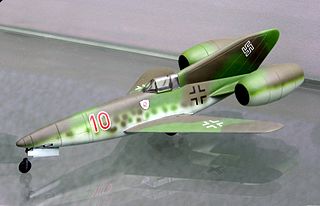
The Focke-Wulf Ta 154 Moskito was a fast twin-engined night fighter aircraft designed by the German aeronautical engineer Kurt Tank and produced by the aircraft manufacturer Focke-Wulf. It was unofficially named Moskito due to its similarities with the de Havilland Mosquito that were already with the Royal Air Force (RAF).

The Focke-Wulf Fw 187 Falke ("Falcon") was a German aircraft designed in 1935. It was conceived by Kurt Tank as a twin-engine, high-performance fighter, but the Luftwaffe saw no role for the design, perceiving it as intermediate between the Messerschmitt Bf 109 and Bf 110. Later prototypes were adapted to two-seats to compete with the Bf 110 in the heavy fighter (Zerstörer) role, but only nine aircraft were built in total.

The Messerschmitt Me 328 was a prototype pulsejet-powered fighter aircraft designed and produced by the German aircraft manufacturer Messerschmitt AG.

The Heinkel HeS 011 or Heinkel-Hirth 109-011(HeS - Heinkel Strahltriebwerke) was an advanced World War II jet engine built by Heinkel-Hirth. It featured a unique compressor arrangement, starting with a low-compression impeller in the intake, followed by a "diagonal" stage similar to a centrifugal compressor, and then a three-stage axial compressor. Many of the German jet-powered aircraft being designed near the end of the war were designed to use the HeS 011, but the engine itself was not ready for production before the war ended in Europe and only small numbers of prototypes were produced.

The Focke-Wulf Fw 57 was a prototype German heavy fighter and fighter-bomber. Prototypes were built in 1936 but never entered production.

The Messerschmitt P.1101 was a single-seat, single-jet fighter project of World War II, developed as part of the 15 July 1944 Emergency Fighter Program which sought a second generation of jet fighters for the Third Reich. A prominent feature of the P.1101 prototype was that the sweep angle of the wings could be changed before flight, a feature further developed in later variable-sweep aircraft such as the Bell X-5 and Grumman XF10F Jaguar.

Hans Multhopp was a German aeronautical engineer/designer. Receiving a degree from the University of Göttingen, Multhopp worked with the famous designer Kurt Tank at the Focke-Wulf Flugzeugbau AG during World War II, and was the leader of the team responsible for the design of the Focke-Wulf Ta 183 lightweight jet fighter, which was the winner of the 1945 Emergency Fighter Competition. Emigrating to the United Kingdom after the war, he assisted in the advancement of British aeronautic science before moving to the United States, where his work for Martin Marietta on lifting bodies provided aerodynamic experience that proved instrumental in the development of the Space Shuttle.

The Arado E.555 was a long range strategic bomber proposed by the German Arado company during World War II in response to the RLM's Amerikabomber project. The E.555 designation was applied to a series of long range jet bomber designs of various sizes, powerplant, crew and weapon load configurations. As design studies only, no aircraft were developed or constructed and the entire E.555 project was cancelled at the end of 1944.

The Focke-Wulf Fw 56 Stösser was a single-engine parasol wing monoplane advanced trainer designed and built by the German aircraft manufacturer Focke-Wulf. It was the company's first aircraft to be designed from the onset by the aeronautical engineer Kurt Tank, who also named the type.
The Focke-Wulf Project I was a design study for a jet fighter, to be built in Germany during World War II. In 1942, the Reichsluftministerium (RLM) asked Professor Kurt Tank of the Focke-Wulf factory to investigate the possibility of a single-engine jet fighter. He was given the development plans of the BMW 003, Jumo 004 and Heinkel HeS 011 engines. Late in 1942 the Project Office, led by Ludwig Mittelhuber, began to work on a series of fighter projects, to be powered by one of these new turbojet units.
The Focke-Wulf Project II was a design study for a single-seat jet fighter, carried out in Germany during World War II.
The Focke-Wulf Peterle was a design study for a turboprop-powered fighter-bomber, undertaken in Germany during World War II.

The Focke-Wulf Strahlrohrjäger was a German swept wing, ramjet-powered interceptor aircraft proposal during World War II. The project was proposed at the same time as the Focke-Wulf Super Lorin and remained only a design study until the surrender of Nazi Germany.

The Heinkel He 74 was a light fighter aircraft developed in Germany in the early 1930s. It was a conventional, single-bay biplane with staggered, unequal-span wings braced with an I-type interplane strut. The pilot sat in an open cockpit, and the undercarriage was of the fixed, tailskid type.

The Heinkel He P.1079 was a projected German V-tail all weather jet fighter designed by Heinkel Flugzeugwerke in the closing stages of World War II. The aircraft was only a design; it was not produced.

The Messerschmitt P.1111 was a jet fighter/interceptor project, designed by Messerschmitt for the Luftwaffe near the end of World War II.

The Messerschmitt P.1110 was a design for a single-seat, high-altitude interceptor, prepared for the German Luftwaffe by the Messerschmitt aircraft manufacturing company, under the Emergency Fighter Program during the last months of World War II.

The Focke-Wulf Volksjäger, was a German emergency fighter project for the Luftwaffe. It was designed by Focke-Wulf towards the end of World War II as part of the defense effort against the devastating Allied bombing raids.

The Gotha Go P.60 was a jet-powered flying wing fighter proposed during World War II by Gothaer Waggonfabrik (Gotha). The initial concept a two-seat multi-role fighter that was subsequently developed into a three-seat night and all-weather fighter, but no variant was ever built.
















